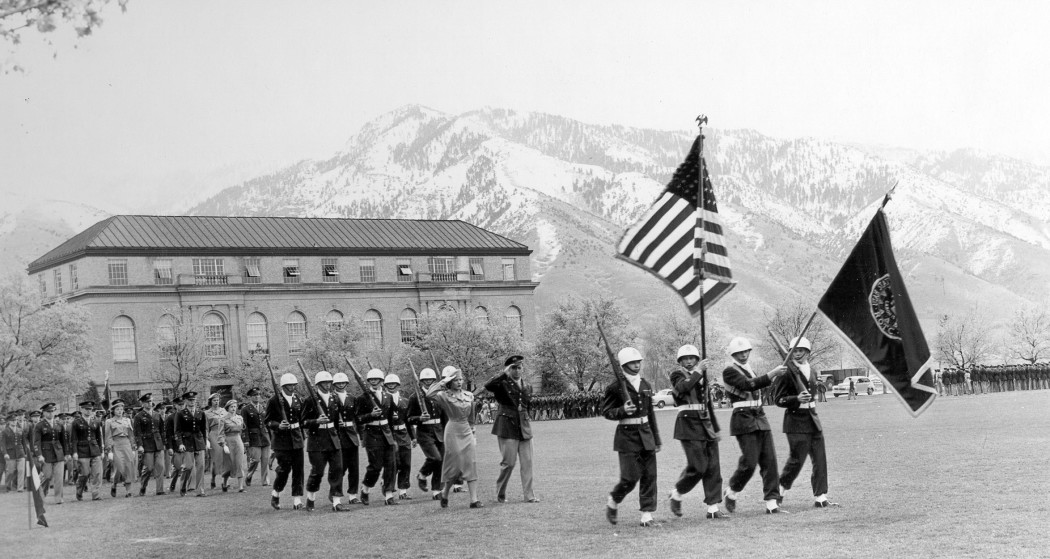A proud legacy: USU Army ROTC celebrates 100 years
This year, ROTC programs across the United States celebrate their 100th birthday. For Utah State University’s Army ROTC, this anniversary means celebrating the proud lineage of a program that was once regarded as one of the biggest and best in the nation.
In 1888, the Agricultural College of Utah, which is now USU, was founded as part of the 1862 Morrill Land-Grant Act, an act that established many universities with a mandatory two years of military tactics training for male students. In 1916, these existing military programs were organized into units of Reserve Officers’ Training Corps, or ROTC’s.
Utah State graduate student and army ROTC cadet Camon Davison has done extensive research on Utah State University’s history. He said the Army ROTC is central to its history and heritage.
“When the United States entered World War I in 1917, the campus was basically shut down and became a basic training site,” Davidson said.
Enlisted soldiers were sent to the USU campus to be taught mechanical arts and trades, and to be trained in military science.
During World War II, approximately 30,000 cadets were trained at Utah State.
E.G. Peterson, president of the University at the time, petitioned the federal government for funds to build barracks for the students. These barracks, the Geology Building and Ray B. West, still stand on USU’s campus today.
“The Quad exists because it was built for military training and drills,” Davison said.
Utah State’s campus once had so many Cadets, though, that it had to take to the old football field and field house for training because they could not all fit on the Quad.
In 1946, E.W. Timberlake, who was a general during World War II, willingly took a demotion to become colonel over USU’s ROTC program. He had high regard for its cadets, who had earned a reputation for their high morals and character. “In about two years, our program became one of the biggest and best in the nation,” Davison said.
The USU ROTC was given the nickname “West Point of the West” because it had the size and prestige comparable to any other U.S. military academy. USU is the only school in ROTC history to be given the rank of “Superior Program.”
“The detachment here is one of the best and most history in the nation,” said current USU army ROTC cadet John Roberts.
This history, he said, gives him immense pride in his enrollment.
“When our detachment is called to attention, we always sound off with our motto, ‘West Point of the West,’ which is a proud call to our heritage,” he said.
USU’s ROTC is not the size it once was. Major Jonathan Kenworthy, current primary instructor of the Army ROTC, said the program commissions about 10 students per year. The program used to commission 500-800 officers per year.
After the Vietnam and Korean Wars ended, many ROTC programs declined. The U.S. government eventually dropped the mandatory training.
In 1997, the USU ROTC program was shut down, but reopened just before 9/11.
“We’re happy to be back,” Kenworthy said.
He said Utah State’s detachment has celebrated the 100-year anniversary of the Army ROTC this week with great pride.
“We had a great turnout for our 5K on Saturday, and we showed a wonderful documentary on our program’s history last Thursday,” he said.
“We’d just like to spark more awareness about our program,” said Dan Whittaker, an SFC.
Though the program has a small footprint on campus, he said, it is an amazing organization and has had an integral part in Utah State University’s history.
“The ROTC program is without a doubt one of the most invaluable experiences in which a college student can engage,” said Jeff Sonderegger, a graduating ROTC cadet. “It has had a profound impact on my life.”
Roberts said his experience in USU’s ROTC has been nothing but positive. “Anybody who walks through the doors of the Military Science Building goes away a changed person,” he said. “The individuals who complete this program will make excellent officers with the training they’ve received here.”

